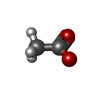[English] 日本語
 Yorodumi
Yorodumi- PDB-9j00: Crystal Structure Sensory Appendage Protein 2 from Anopheles culi... -
+ Open data
Open data
- Basic information
Basic information
| Entry | Database: PDB / ID: 9j00 | |||||||||
|---|---|---|---|---|---|---|---|---|---|---|
| Title | Crystal Structure Sensory Appendage Protein 2 from Anopheles culicifacies in space group P21 with three molecules per ASU | |||||||||
 Components Components | Chemosensory protein 3 | |||||||||
 Keywords Keywords | LIPID BINDING PROTEIN / Sensory Appendage Protein 2 / SAP2 / Mosquito / Olfaction / hydrophobic chemicals / Vector Control | |||||||||
| Function / homology | Insect odorant-binding protein A10/Ejaculatory bulb-specific protein 3 / Insect odorant-binding protein A10/Ejaculatory bulb-specific protein 3 superfamily / Insect pheromone-binding family, A10/OS-D / ACETATE ION / : / Chemosensory protein 3 Function and homology information Function and homology information | |||||||||
| Biological species |  | |||||||||
| Method |  X-RAY DIFFRACTION / X-RAY DIFFRACTION /  SYNCHROTRON / SYNCHROTRON /  SAD / Resolution: 1.828 Å SAD / Resolution: 1.828 Å | |||||||||
 Authors Authors | Goswami, R. / Biswas, S. / Chakraborti, S. / Manickam, Y. | |||||||||
| Funding support |  India, 2items India, 2items
| |||||||||
 Citation Citation |  Journal: To Be Published Journal: To Be PublishedTitle: Crystal Structure and Ligand Binding Studies of Chemosensory and Sensory Appendage Proteins Authors: Biswas, S. / Goswami, R. / Barbosa, R.L. / Sung, S. / Marquez, J.A. / Chakraborti, S. / Manickam, Y. | |||||||||
| History |
|
- Structure visualization
Structure visualization
| Structure viewer | Molecule:  Molmil Molmil Jmol/JSmol Jmol/JSmol |
|---|
- Downloads & links
Downloads & links
- Download
Download
| PDBx/mmCIF format |  9j00.cif.gz 9j00.cif.gz | 147.3 KB | Display |  PDBx/mmCIF format PDBx/mmCIF format |
|---|---|---|---|---|
| PDB format |  pdb9j00.ent.gz pdb9j00.ent.gz | 114.5 KB | Display |  PDB format PDB format |
| PDBx/mmJSON format |  9j00.json.gz 9j00.json.gz | Tree view |  PDBx/mmJSON format PDBx/mmJSON format | |
| Others |  Other downloads Other downloads |
-Validation report
| Summary document |  9j00_validation.pdf.gz 9j00_validation.pdf.gz | 11.6 MB | Display |  wwPDB validaton report wwPDB validaton report |
|---|---|---|---|---|
| Full document |  9j00_full_validation.pdf.gz 9j00_full_validation.pdf.gz | 11.6 MB | Display | |
| Data in XML |  9j00_validation.xml.gz 9j00_validation.xml.gz | 19.5 KB | Display | |
| Data in CIF |  9j00_validation.cif.gz 9j00_validation.cif.gz | 26.6 KB | Display | |
| Arichive directory |  https://data.pdbj.org/pub/pdb/validation_reports/j0/9j00 https://data.pdbj.org/pub/pdb/validation_reports/j0/9j00 ftp://data.pdbj.org/pub/pdb/validation_reports/j0/9j00 ftp://data.pdbj.org/pub/pdb/validation_reports/j0/9j00 | HTTPS FTP |
-Related structure data
| Similar structure data | Similarity search - Function & homology  F&H Search F&H Search |
|---|
- Links
Links
- Assembly
Assembly
| Deposited unit | 
| ||||||||
|---|---|---|---|---|---|---|---|---|---|
| 1 | 
| ||||||||
| 2 | 
| ||||||||
| 3 | 
| ||||||||
| Unit cell |
|
- Components
Components
| #1: Protein | Mass: 13152.870 Da / Num. of mol.: 3 Source method: isolated from a genetically manipulated source Source: (gene. exp.)   #2: Chemical | ChemComp-CD / #3: Chemical | ChemComp-CL / #4: Chemical | ChemComp-ACT / | #5: Water | ChemComp-HOH / | Has ligand of interest | Y | Has protein modification | Y | |
|---|
-Experimental details
-Experiment
| Experiment | Method:  X-RAY DIFFRACTION / Number of used crystals: 1 X-RAY DIFFRACTION / Number of used crystals: 1 |
|---|
- Sample preparation
Sample preparation
| Crystal | Density Matthews: 2.19 Å3/Da / Density % sol: 43.74 % |
|---|---|
| Crystal grow | Temperature: 293 K / Method: vapor diffusion, hanging drop / pH: 4.6 Details: 0.1 M Lithium chloride, 0.1 M Sodium acetate pH 4.5, 30% v/v PEG 400, 0.1 M Cadmium chloride hemi(pentahydrate) |
-Data collection
| Diffraction | Mean temperature: 100 K / Serial crystal experiment: N |
|---|---|
| Diffraction source | Source:  SYNCHROTRON / Site: SYNCHROTRON / Site:  Diamond Diamond  / Beamline: I03 / Wavelength: 0.9763 Å / Beamline: I03 / Wavelength: 0.9763 Å |
| Detector | Type: DECTRIS EIGER2 XE 16M / Detector: PIXEL / Date: Feb 25, 2024 |
| Radiation | Protocol: SINGLE WAVELENGTH / Monochromatic (M) / Laue (L): M / Scattering type: x-ray |
| Radiation wavelength | Wavelength: 0.9763 Å / Relative weight: 1 |
| Reflection | Resolution: 1.828→78.968 Å / Num. obs: 30282 / % possible obs: 98.9 % / Redundancy: 5.4 % / CC1/2: 0.996 / Rrim(I) all: 0.15 / Net I/σ(I): 8.5 |
| Reflection shell | Resolution: 1.828→1.86 Å / Redundancy: 3.7 % / Num. unique obs: 1306 / CC1/2: 0.358 / Rrim(I) all: 1.932 / % possible all: 86.8 |
- Processing
Processing
| Software |
| ||||||||||||||||||||||||||||||||||||||||||||||||||||||||||||||||||||||||||||||||||||
|---|---|---|---|---|---|---|---|---|---|---|---|---|---|---|---|---|---|---|---|---|---|---|---|---|---|---|---|---|---|---|---|---|---|---|---|---|---|---|---|---|---|---|---|---|---|---|---|---|---|---|---|---|---|---|---|---|---|---|---|---|---|---|---|---|---|---|---|---|---|---|---|---|---|---|---|---|---|---|---|---|---|---|---|---|---|
| Refinement | Method to determine structure:  SAD / Resolution: 1.828→78.968 Å / SU ML: 0.21 / Cross valid method: FREE R-VALUE / σ(F): 1.36 / Phase error: 22.92 / Stereochemistry target values: ML SAD / Resolution: 1.828→78.968 Å / SU ML: 0.21 / Cross valid method: FREE R-VALUE / σ(F): 1.36 / Phase error: 22.92 / Stereochemistry target values: ML
| ||||||||||||||||||||||||||||||||||||||||||||||||||||||||||||||||||||||||||||||||||||
| Solvent computation | Shrinkage radii: 0.9 Å / VDW probe radii: 1.11 Å / Solvent model: FLAT BULK SOLVENT MODEL | ||||||||||||||||||||||||||||||||||||||||||||||||||||||||||||||||||||||||||||||||||||
| Refinement step | Cycle: LAST / Resolution: 1.828→78.968 Å
| ||||||||||||||||||||||||||||||||||||||||||||||||||||||||||||||||||||||||||||||||||||
| Refine LS restraints |
| ||||||||||||||||||||||||||||||||||||||||||||||||||||||||||||||||||||||||||||||||||||
| LS refinement shell |
| ||||||||||||||||||||||||||||||||||||||||||||||||||||||||||||||||||||||||||||||||||||
| Refinement TLS params. | Method: refined / Origin x: 25.97 Å / Origin y: -16.0311 Å / Origin z: 12.5174 Å
| ||||||||||||||||||||||||||||||||||||||||||||||||||||||||||||||||||||||||||||||||||||
| Refinement TLS group | Selection details: all |
 Movie
Movie Controller
Controller


 PDBj
PDBj






